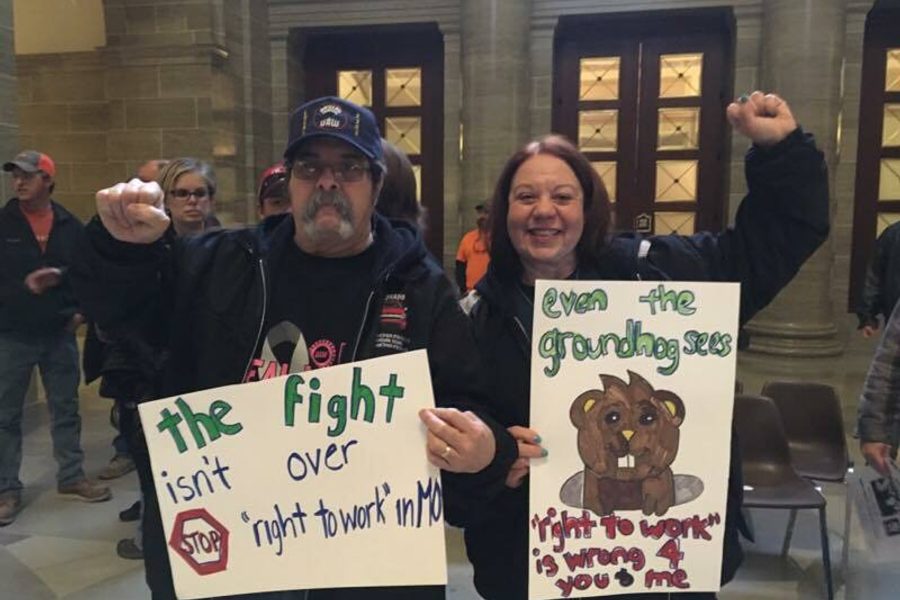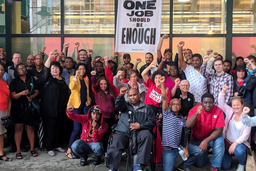
Missouri’s House of Representatives passed a so-called “right-to-work” law this month, marking the end of a decades-long campaign for the adoption of the anti-union legislation in the state.
The measure had already been passed in Missouri’s Senate and newly-installed Gov. Eric Greitens has pledged to sign the law soon. Once he does, Missouri will become the 28th state to have such a law on the books.
The likelihood the law would be passed after years of lobbying by the Missouri Chamber of Commerce and Industry became clear on Election Day, when Greitens defeated a union-friendly Democratic Party candidate for governor. Greitens and his opponent had been vying to replace retiring Gov. Jay Nixon, an eight-year incumbent who had staunchly resisted the advance of right-to-work legislation during his two terms in the state capital.
The Kansas City Star reported a lopsided House vote on Thursday of 100-59 in favor of the legislation. The Senate had passed the same measure 21-12.
The new law follows the pattern of similar legislation passed recently in Kentucky and West Virginia. (A nationwide right-to-work law was also introduced in Congress last week.) It prohibits any requirement that a worker be a union member as a condition of employment, and prevents unions from collecting membership dues from the workers it represents unless the worker specifically authorizes the payment. The effect is to impair the ability of unions to maintain effective recruiting operations and financial management, labor advocates say.
Efforts by the Missouri AFL-CIO to prevent passage of the right-to-work law were a long shot ever since the results of 2016 election became known, says the labor federation’s president, Mike Louis.
“This has been a long fight. We lost the Senate in 2002 and then we lost the House in 2006. But Gov. Nixon always supported us,” he tells In These Times.
Louis adds that that the efforts of the Missouri Chamber of Commerce were given a major boost by wealthy Joplin, Missouri, businessman David Humphreys, who donated generously to promote right-to-work.
“These big corporate types like David Humphreys pay millions to buy these seats,” in the legislature, Louis says.
But Missouri unions are not accepting defeat, and have already developed a counter-campaign to neutralize the law, Louis continues. The AFL-CIO will lead an effort to collect enough signatures to place an initiative on the 2018 state ballot to reverse the right-to-work law, he says.
“Missouri law says we need 250,000 signatures to get our initiative on the ballot. We will absolutely be able to get this number, and I’m convinced we can win an election when the people of Missouri are presented with a plain choice,” Louis says.
In the meantime, individual unions will struggle to convince union members to maintain their membership. Philip Dine, a journalist and author who spent more than two decades as a reporter for the St. Louis Post-Dispatch, says the United Food and Commercial Workers Union (UFCW) and the International Brotherhood of Teamsters are the two unions that are likely to feel the most immediate impact of the new law.
“UFCW and Teamsters are pretty strong in the St. Louis area. But the grocery store workers in the UFCW are going to come under a lot of pressure. A lot of those jobs don’t pay all that well to start with, so it’s not going to be easy to convince workers that union dues are worth the money,” says Dine, author of the widely-acclaimed State of the Unions: How Labor Can Strengthen the Middle Class, Improve our Economy, and Regain Political Influence. Also coming under pressure to quit their unions will be aircraft production workers represented by the International Association of Machinists and assembly line workers represented by the United Auto Workers, Dine says.
“Sure, there will be a touch — absolutely. But I think it is going to be de minimis,” says David Cook, president of 10,000-member UFCW Local 655 in St. Louis. About 85 percent of the local membership is in the retail grocery sector, he says, so “we are going to have to do a better job of communicating union value to our members. This is something we have been doing already, but we’ll need to do more.”
UFCW will throw its full weight behind the AFL-CIO effort to amend the state constitution to protect workers’ union rights, Cook says.
“We’ve been fighting the right-to-work fight here [in Missouri] on an almost daily basis for the last five years. We are already geared up and I think Missouri is ahead of a lot of other states that have thought about an electoral initiative over right-to-work,” he says. “We’ve communicated with voters. We have a head start.”
“Mega-donors like David Humphries have figured out how to buy politicians. But when the issue of better wages and better worker safety are put directly to the voters, we’ll do well,” Cook predicts.






